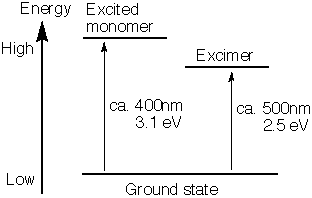Excimer: Difference between revisions
No edit summary |
|||
| Line 19: | Line 19: | ||
In [[organic chemistry]] many reactions occur through an exciplex for example those of simple [[arene compound]]s with alkenes: <ref>''Photochemistry of Arenes—Reloaded'' Jochen Mattay [[Angew. Chem. Int. Ed.]] '''2007''', 46, 663 – 665 {{DOI|10.1002/anie.200603337}}</ref> The reactions of [[benzene]] and their products depicted are a [2+2]cycloaddition to the ortho product (A) <ref>''1-cyanobicyclo[4.2.0]octa-2,4-dienes and their synthesis'' United States Patent 2,805,242 Issue Date: September 3, '''1957''' [http://patimg1.uspto.gov/.piw?Docid=02805242&homeurl=http%3A%2F%2Fpatft.uspto.gov%2Fnetacgi%2Fnph-Parser%3FSect1%3DPTO2%2526Sect2%3DHITOFF%2526p%3D1%2526u%3D%25252Fnetahtml%25252FPTO%25252Fsearch-bool.html%2526r%3D1%2526f%3DG%2526l%3D50%2526co1%3DAND%2526d%3DPALL%2526s1%3D2805242.PN.%2526OS%3DPN%2F2805242%2526RS%3DPN%2F2805242&PageNum=&Rtype=&SectionNum=&idkey=NONE&Input=View+first+page Link]</ref>., a [2+3]cycloaddition to the meta product (B) <ref>''A Photochemical 1,3 Cycloaddition of Olefins to Benzene'' K. E. Wilzbach and Louis Kaplan [[J. Am. Chem. Soc.]]; '''1966'''; 88(9) pp 2066 - 2067; {{DOI|10.1021/ja00961a052}}</ref> and the [2+4]cycloaddition to the [[Arene substitution patterns|para product]] (C) <ref>''Photoaddition of benzene to olefins. II. Stereospecific 1,2 and 1,4 cycloadditions'' Kenneth E. Wilzbach and Louis Kaplan [[J. Am. Chem. Soc.]]; '''1971'''; 93(8) pp 2073 - 2074; {{DOI|10.1021/ja00737a052}}</ref> with simple alkenes such as the isomers of [[2-butene]]. In these reactions it is the arene that is excited. |
In [[organic chemistry]] many reactions occur through an exciplex for example those of simple [[arene compound]]s with alkenes: <ref>''Photochemistry of Arenes—Reloaded'' Jochen Mattay [[Angew. Chem. Int. Ed.]] '''2007''', 46, 663 – 665 {{DOI|10.1002/anie.200603337}}</ref> The reactions of [[benzene]] and their products depicted are a [2+2]cycloaddition to the ortho product (A) <ref>''1-cyanobicyclo[4.2.0]octa-2,4-dienes and their synthesis'' United States Patent 2,805,242 Issue Date: September 3, '''1957''' [http://patimg1.uspto.gov/.piw?Docid=02805242&homeurl=http%3A%2F%2Fpatft.uspto.gov%2Fnetacgi%2Fnph-Parser%3FSect1%3DPTO2%2526Sect2%3DHITOFF%2526p%3D1%2526u%3D%25252Fnetahtml%25252FPTO%25252Fsearch-bool.html%2526r%3D1%2526f%3DG%2526l%3D50%2526co1%3DAND%2526d%3DPALL%2526s1%3D2805242.PN.%2526OS%3DPN%2F2805242%2526RS%3DPN%2F2805242&PageNum=&Rtype=&SectionNum=&idkey=NONE&Input=View+first+page Link]</ref>., a [2+3]cycloaddition to the meta product (B) <ref>''A Photochemical 1,3 Cycloaddition of Olefins to Benzene'' K. E. Wilzbach and Louis Kaplan [[J. Am. Chem. Soc.]]; '''1966'''; 88(9) pp 2066 - 2067; {{DOI|10.1021/ja00961a052}}</ref> and the [2+4]cycloaddition to the [[Arene substitution patterns|para product]] (C) <ref>''Photoaddition of benzene to olefins. II. Stereospecific 1,2 and 1,4 cycloadditions'' Kenneth E. Wilzbach and Louis Kaplan [[J. Am. Chem. Soc.]]; '''1971'''; 93(8) pp 2073 - 2074; {{DOI|10.1021/ja00737a052}}</ref> with simple alkenes such as the isomers of [[2-butene]]. In these reactions it is the arene that is excited. |
||
[[Image:Arenephotocycloadditions. |
[[Image:Arenephotocycloadditions.|400px|center|Arene photocycloadditions]] |
||
As a general rule the [[regioselectivity]] is in favor of the ortho adduct at the expense of the meta adduct when the amount of charge transfer taking place in the exciplex increases |
As a general rule the [[regioselectivity]] is in favor of the ortho adduct at the expense of the meta adduct when the amount of charge transfer taking place in the exciplex increases |
||
==References== |
==References== |
||
Revision as of 12:03, 19 January 2008

An excimer[1] (originally short for excited dimer) is a short-lived dimeric or heterodimeric molecule formed from two species, at least one of which is in an electronic excited state. Excimers are often diatomic and are formed between two atoms or molecules that would not bond if both were in the ground state. The lifetime of an excimer is very short, on the order of nanoseconds. Binding of a larger number of excited atoms form Rydberg matter clusters the lifetime of which can exceed many seconds.
Formation and decay
Under the molecular orbital formalism, a typical ground-state molecule has electrons in the lowest possible energy levels. According to Hund's rule, at most two electrons can occupy a given orbital, and if an orbital contains two electrons they must be in opposite spin states. The highest occupied molecular orbital is called the HOMO and the lowest unoccupied molecular orbital is called the LUMO; the energy gap between these two states is known as the HOMO/LUMO gap. If the molecule absorbs light whose energy is larger than this gap, an electron in the HOMO may be excited to the LUMO. This is called the molecule's excited state.
Excimers are only formed when one of the dimer components is in the excited state. When the excimer returns to the ground state, its components dissociate and often repel each other. The wavelength of an excimer's emission is longer (smaller energy) than that of the excited monomer's emission. An excimer can thus be measured by fluorescent emissions.
Because excimer formation is dependent on a bimolecular interaction, it is promoted by high monomer density. Low-density conditions produce excited monomers that decay to the ground state before they interact with an unexcited monomer to form an excimer.
Usage note
The term excimer (excited state complex) is, strictly speaking, limited to cases in which a true dimer is formed; that is, both components of the dimer are the same molecule or atom. The term exciplex refers to the heterodimeric case; however, common usage expands excimer to cover this situation.
Examples and use
Heterodimeric diatomic complexes involving a noble gas and a halide, such as xenon chloride, are common in the construction of excimer lasers, which are excimers' most common application. These lasers take advantage of the fact that excimer components have attractive interactions in the excited state and repulsive interactions in the ground state. The molecule pyrene is another canonical example of an excimer that has found applications in biophysics to evaluate the distance between biomolecules[2].
In organic chemistry many reactions occur through an exciplex for example those of simple arene compounds with alkenes: [3] The reactions of benzene and their products depicted are a [2+2]cycloaddition to the ortho product (A) [4]., a [2+3]cycloaddition to the meta product (B) [5] and the [2+4]cycloaddition to the para product (C) [6] with simple alkenes such as the isomers of 2-butene. In these reactions it is the arene that is excited.

As a general rule the regioselectivity is in favor of the ortho adduct at the expense of the meta adduct when the amount of charge transfer taking place in the exciplex increases
References
- ^ Birks, JB "Excimers", Rep. Prog. Phys. 1975, 38, 903-974.
- ^ Conibear PB, Bagshaw CR, Fajer PG, Kovacs M, Malnasi-Csizmadia A. (2003). Myosin cleft movement and its coupling to actomyosin dissociation. Nat Struct Biol 10(10):831-5.
- ^ Photochemistry of Arenes—Reloaded Jochen Mattay Angew. Chem. Int. Ed. 2007, 46, 663 – 665 doi:10.1002/anie.200603337
- ^ 1-cyanobicyclo[4.2.0]octa-2,4-dienes and their synthesis United States Patent 2,805,242 Issue Date: September 3, 1957 Link
- ^ A Photochemical 1,3 Cycloaddition of Olefins to Benzene K. E. Wilzbach and Louis Kaplan J. Am. Chem. Soc.; 1966; 88(9) pp 2066 - 2067; doi:10.1021/ja00961a052
- ^ Photoaddition of benzene to olefins. II. Stereospecific 1,2 and 1,4 cycloadditions Kenneth E. Wilzbach and Louis Kaplan J. Am. Chem. Soc.; 1971; 93(8) pp 2073 - 2074; doi:10.1021/ja00737a052
